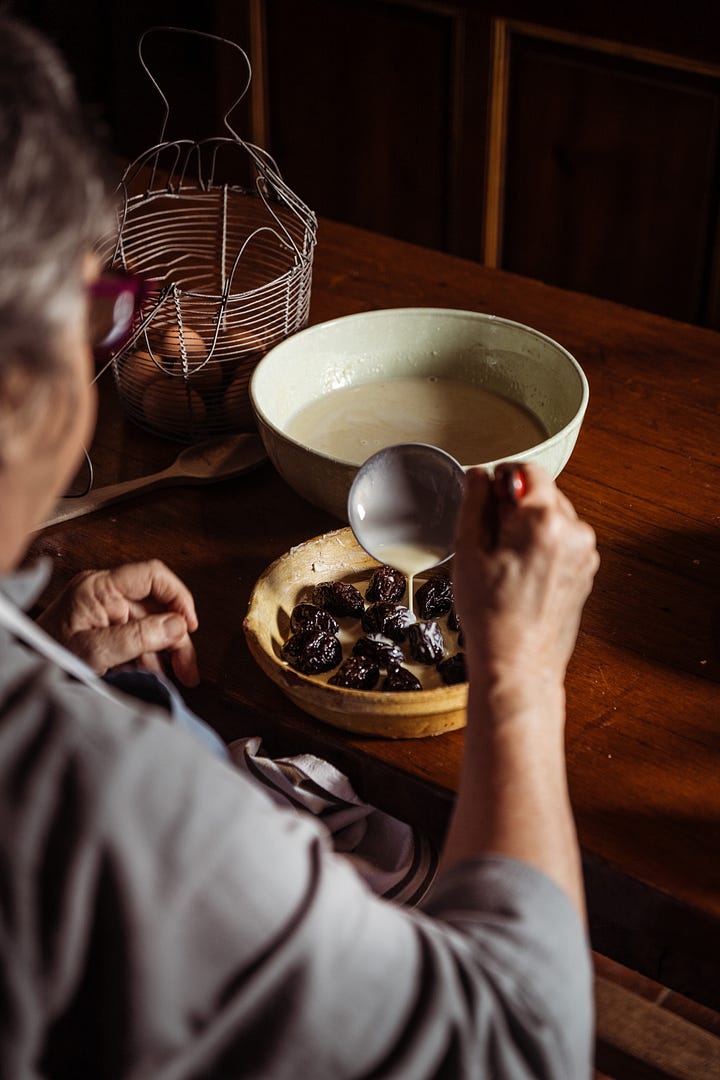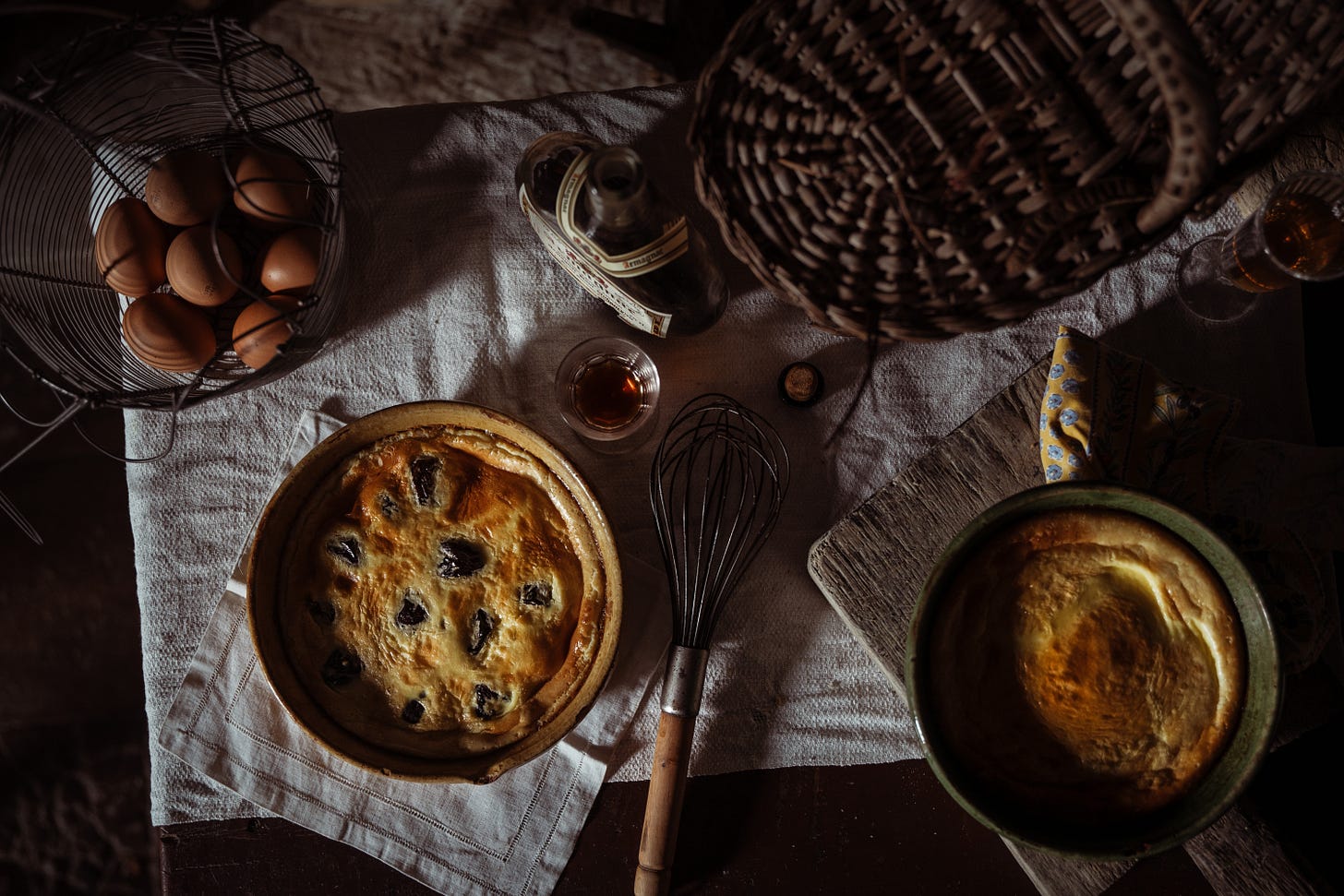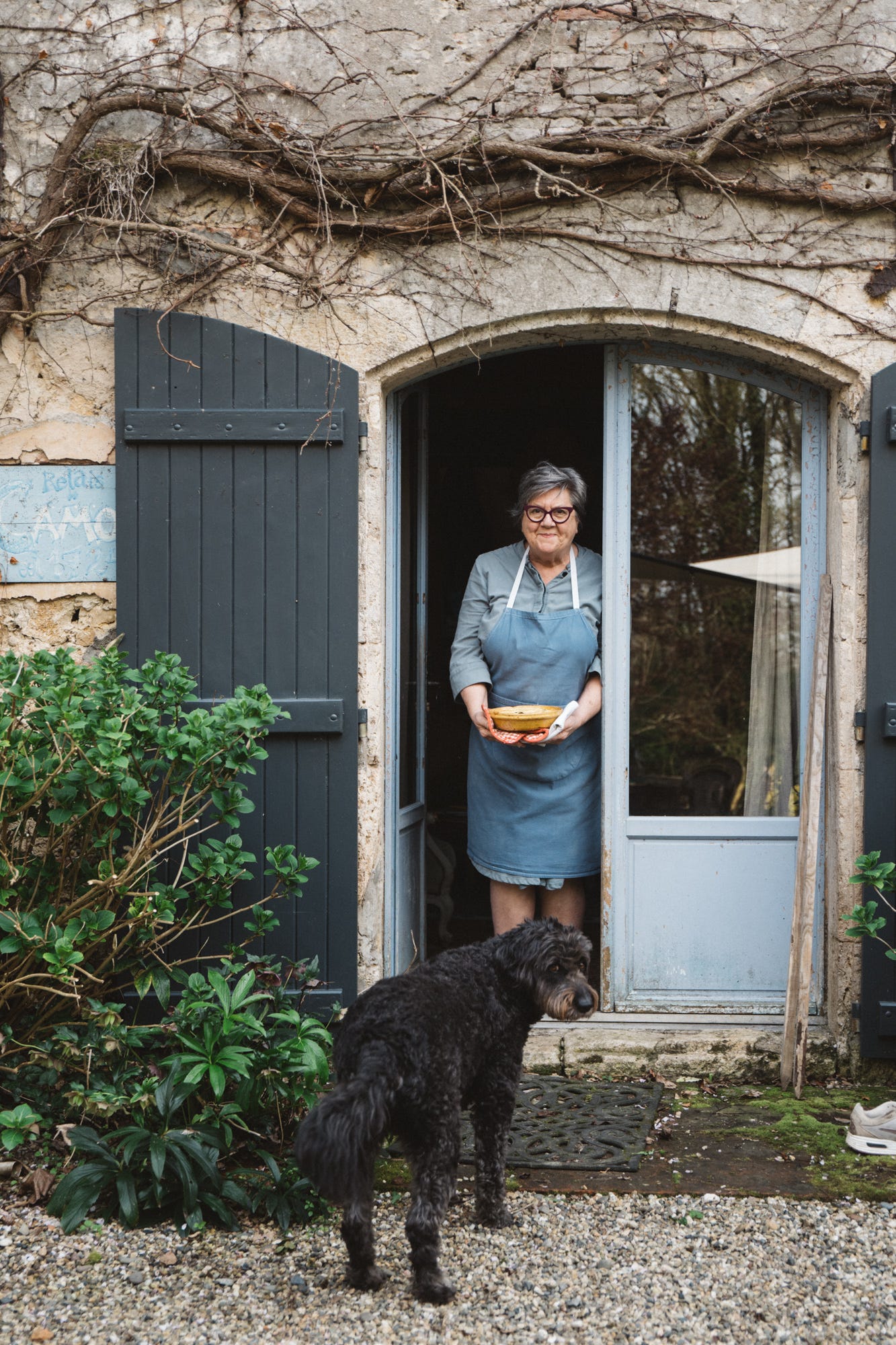Clafoutis: Thirty Years in the Making
Finding France an *Annotated Recipe When Valentina comes to town.

This week, talented photographer, writer, and cook Valentina Solfrini arrived for a week of quiet inspiration at the Relais de Camont. We met at one of Ruth Ribeaucourt’s Faire Press creative retreats in Provence and kept in touch mainly on Instagram. When I saw that Valentina was nearby in Toulouse, I invited her for a creative visit.
Valentina is sharing her Italian kitchen on Substack at L’Appetito. So, to celebrate our Substack cross-generational interests in authentic home-inspired recipes, whether Italian or French, we decided to collaborate on a delicious dessert featuring our most famous local product—les pruneaux d’Agen. We went to a small village market together, bought the makings of several good meals, and came home to soak up the Spring sunshine and cook in my old kitchen.
We are sharing this post on both of our publications. In the spirit of good Substack vibes, this post is free to all, and we hope you will share our work with your food-loving friends.
Clafoutis aux Pruneaux
Clafoutis aux Pruneaux is made with pruneaux d’Agen, the soft, mi-cuit dried plums grown just down the road at la Ferme Roques. Their Prune d’Ente orchards are all in snowy white blossom right now !
When a fellow cook asked me to share my clafoutis recipe because her custard turned out rubbery and tough, I paused just long enough to realize what a daunting task this was. After years of making this classic French fruit custard dessert, I have had all the clafoutis fails: tough, watery, separated, insipid, uninspired, and embarrassing pronunciation. But how do you put that in a simple recipe? More words?
Cla-Fou-Tis: say “kla-foo-tea” with no accent on any syllable.
So, I started with the original recipe I made for my first book, A Culinary Journey in Gascony, and annotated it with the little edits and asides that I shared with Valentina as she photographed and filmed the simple process at my kitchen table. This is now the definitive version, as edited in my latest 25th-anniversary e-book edition of A Culinary Journey in Gascony. (available here)




Kate Hill’s *Annotated Recipe for Clafoutis aux Pruneaux
The *annotations are in Bold and Italics.
A sort of custard-cake with prunes
Serves 6
More of a custard/flan than a cake, this egg-cream dessert is a favorite in France, especially throughout the Gascon countryside. In the north of France *actually Limousin where Clafoutis is credited is in the north of Aquitaine but center of France; Limoges is its main city, clafoutis is made with cherries in season, pears, or other fruit. But in Gascony, where succulent preserved plums abound year-round, the jam-like texture of slow-baked prunes steeped in Armagnac adds a chewy richness to this homey dessert. *I like to serve it still warm after cooling some from the oven.
1 tablespoon butter * this is to butter the pan. I like to use a thick ovenproof terracotta gratin pan from my collection from the Poterie Not Freres about two to three inches deep. The thick walls allow the batter to cook slowly. If using a metal pan, you might consider using a bain-marie or starting the clafoutis in a cold oven.
1/2 lb (225 g) soft, pitted prunes *Okay, in full disclosure, I do not pitt my prunes. Nobody in France does, nor do we pitt the cherries, as that allows the juices to bleed into the batter. The prunes I buy here, called mi-cuit, or half-cooked, are already soft, having just been dehydrated for 12 hours instead of 24. They don’t need soaking.
1/4 cup (2 fl oz/60 ml) Armagnac or brandy *or wine (for a nonalcoholic substitute, use hot tea)
5 tablespoons flour * the original recipe called for 6 Tablespoon flour, and in an effort to simplify measuring, I reduced it to one Tablespoon per egg. All-purpose flour is fine here, although softer pastry flour would work as well. And, of course, the best and freshest flour is important, too; the better it will taste.
5 tablespoons sugar *my French sugar is a little coarse, so I make sure the batter sits and is stirred long enough to dissolve the sugar completely.
5 eggs *super fresh, rich, dark yellow farm eggs. Otherwise, why bother?
3 cups (24 fl oz/720 ml) milk *same as for the eggs here- I buy fresh whole/full fat milk straight from the farm, and raw. If using commercial milk, consider adding some cream to up the richness of the milk. The milk is cold, straight form the fridge, the eggs are room temp, but the batter will be cold when put in the oven and that is one tip to having a silkier clafoutis- it takes longer to come to temperature and bakes slower at a lower oven temp (350’/175) so the protein of milk and eggs and flour bound together in a more gentle way and produce a more tender texture.
1 pinch of salt! *I forgot to add this in the earlier version.
1. Preheat the oven to 350°F (175°C). * okay, this is one of those confusing things. I am a very fast cook. By turning the oven on before I start mixing, it will be just hot enough. There is no need to turn the oven on an hour before you start baking. Butter a shallow 1-1/2-quart baking dish *the pan has to be deep enough to let the clafoutis cook slowly, so it should be about three inches. Measure your pan so that it will hold 1-½ qt or liters (the amount of batter you will have) or use two smaller dishes. And powder with a little sugar or flour. * I forget to do this sometimes.
2. Soak the prunes in the Armagnac (or hot tea) at least 30 minutes, or until they have absorbed most of the liquid. This can be done a day or more in advance. * As mentioned, I did not soak my prunes, which were already soft enough. But you can start this before you do anything else, and by the time you assemble, mix, etc, your prunes will be soaked enough and absorbed enough flavor from the armagnac.
3. In a large bowl, mix the flour and sugar * and the salt. Beat the eggs in another bowl. Pour the beaten eggs into the flour and sugar and, with a whisk, add the milk little by little until all is well mixed. * Okay, never, ever, ever would I use 2 bowls now. in a big enough bowl, I added the eggs, and whisked well until golden smooth and ribbons. Next, I measure the flour and sugar (and salt) in and whisk until the dry ingredients are incorporated into the eggs. Then add one cup of the milk and whisk until the batter is loosened and the lumps are all dispersed; continue to add the remaining two cups of milk one at a time. Whisk enough to make a homogeneous thin batter. At this time, you can let it sit while you arrange the fruit in the pan.
4. Drain the prunes well and arrange in the pan in an even layer. * you do not have to fill the pan with fruit. Just use enough so every serving will have enough fruit. Pour any leftover Armagnac into the batter and mix. (If you have used hot tea, discard any leftover liquid.)
5. Pour the batter carefully around and over the prunes without disturbing them. * use a ladle to be even more careful not to disturb the fruit; fill the pan just to the top of the fruit, or half an inch below the edge allowing it puff up some while baking.
6. Bake for 45 minutes or until a knife inserted in the center of the casserole comes out clean. *Okay, I am rethinking this to make a softer custard. Depending on your pan is depth, this can be done in 30-35 minutes, allowing a little jiggle of softness. The top surface will be bubbled up and uneven, golden to middle brown, and you can see the edges on the buttered pan are browned as well. So check thr clafoutis at 30 minutes and monitor until done to your desires.
Let cool completely and serve from the pan or unmold on a serving platter. * I don't think I have unmolded a clafoutis in years! This will be just as delicious served the next day as the aromatized prunes continue to perfume the “cake.” * and yes, I love it chilled the next day straight from the fridge as well as just baked and warm from the oven.
Variation—Millas
To make millas, a traditional cornmeal version of a custard-cake of Gascony, substitute very finely ground cornmeal for half of the flour. Let the cornmeal hydrate in the batter for at least 30 minutes to an hour before baking. It depends on how coarse the cornmeal is. Regrind commercial cornmeal in a clean coffee mill to get the finer-textured farine de maiz or corn flour, *not corn starch, available in France.
I hope you see how a recipe can change, reflect a different style, and improve over time. It’s such a simple recipe that each ingredient is critical: the sureness of hand, understanding your oven and knowing which pan or pot to cook in. I also hope you love Valentina’s photographs as much as I do and the notes she added to her own post—read her L’Appetito here!
P.S. I just added a Clafoutis video here for paid subscribers.











In my youth, I acquired a taste for Armagnac after I liberated a very nice bottle of the stuff from a French television chef who was being horrible to me and since that time, the amount of Armagnac I've drunk in Gascony could float a battleship. And I've actually been looking for a good clafoutis recipe because I've always been hit or miss with them so I will definitely be giving this a go
Thank you Kate. I have been making clafoutis for many many years first I. The season with cherries then later with apricots, etc. Rarely turns out anything other than good to perfect. This summer in Melbourne I had one perfect then 3!!! very ordinary to not very good at all. Have no idea why. Perhaps I was hurrying. Perhaps I used too much fruit. Have no idea. But a lifetime of cooking has taught me that this happens to the best of cooks. Now it is autumn I will make a pruneaux version. Fingers crossed. 😊